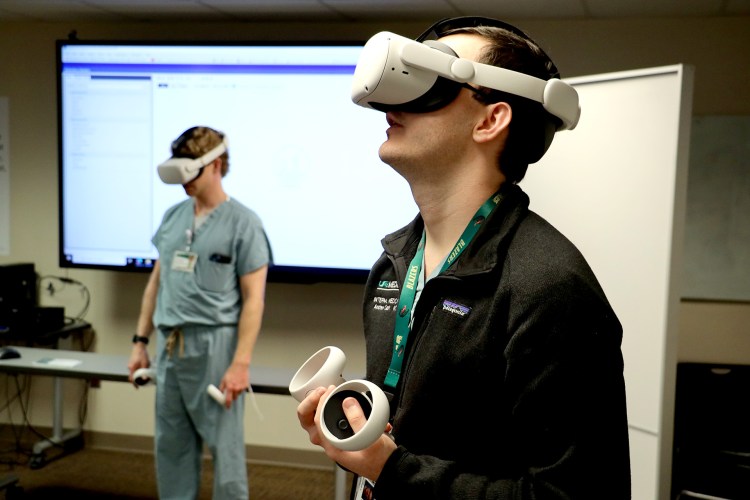Virtues of Virtual: VR offers immersive, flexible learning

The setting may be virtual, but the lessons are real.
UAB Clinical Simulation has offered virtual reality learning since 2019, providing an ever-expanding variety of modules to health-care team members across UAB Medicine. And according to immersive simulation director Andres Viles, its uses are virtually endless.
“I think it’s on par with the in-person experience,” he said. “From the experiences we’re providing, learners are able to remain on the cutting edge of health-care training, ultimately improving patient care. There is so much potential for VR in clinical simulation, with much more to come in the future.”
Currently, Clin Sim offers VR modules based in emergency care, the operating room, and labor and delivery. Although each module differs in content, they all impart a similar takeaway — convenience.
“When compared to traditional, immersive, in-person experiences, virtual reality is less resource-intensive, in terms of personnel, space and equipment,” Viles said.
As an example, when Viles hosts a medical intensive care unit simulation, that one experience will include at least one operations specialist, one embedded participant, a faculty facilitator, a conference room for briefing and debriefing, a simulation room, a manikin, monitors and all the other associated equipment.
“Not to mention the time and effort of everyone supporting the sim,” Viles added. “Compare that to the VR ACLS (advanced cardiovascular life support) session I host, with a similar number of learners. I can have one room, one operations specialist and then just the VR devices.”
Further, these simulation experiences can be offered outside of the simulation space, including with UAB Clinical Simulation’s Mobile Simulation Lab.
“We can take this outside of our simulation space to other places we normally couldn’t go to with immersive sim,” Viles said. “Also, we could potentially offer these opportunities from the comfort of someone’s own home.”
Another benefit of VR?
“Learners can try and try again,” Viles said. “They have multiple opportunities to do so, whereas in our traditional experiences, they only come for one session.”
Madison Granger, first-year internal medicine resident, took advantage of such an opportunity — twice. She completed the ACLS module during her MICU rotation and repeated it this past October.
“With anything, especially in life-and-death situations like ACLS, the more you do it, the more you’ll remember,” Granger said. “So, when it happens in real life, you’ll be much better prepared.”
Granger had never partaken in a VR experience until her first ACLS foray but said she would recommend it to colleagues and other members of the health-care team.
“It’s a unique learning experience, where you can feel immersed in the scenario without the pressure of being in a real-life situation,” she said.
Viles noted that more and more departments throughout UAB Medicine are embracing VR as a learning tool, including the OB/GYN residency program and neurology department, simulations for which he hopes to commence in 2024.
“We’re always listening to our stakeholders,” he said. “And there’s always an opportunity to reach out to us. We’re glad to talk to anyone about their needs and how UAB Simulation can help them meet those needs.”
To learn more or register for a course, visit here.




0 Comments